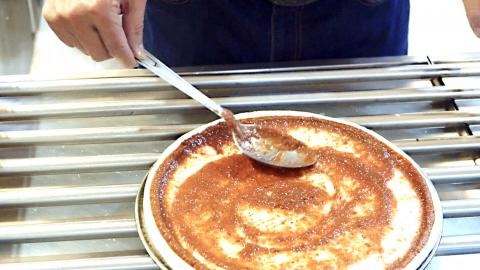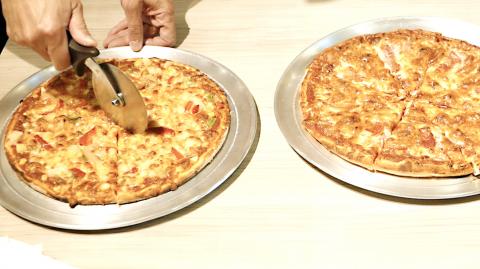Located on Fuxing S Road (復興南路), Chicago Pizza Factory is hard to miss with its open windows and neon signs. Decorated with Native American figures, toy soldiers, collectible airplane models and many other seemingly random knickknacks, the atmosphere of the joint is quiet but feels friendly enough. The main attraction, of course, is the pizza.
As our party of four enters, we are greeted by the owner who emerges from the open kitchen with the single-page menu that displays 17 varieties of American-style pizza, ranging from 9 inches to 14 inches and priced between NT$320 and NT$660. The back page details five sets that include pasta and drinks. Our group stuck to the pizza and ordered a Lucky No 7 (NT$590) and a Chicago No 5 (NT$530), both 14 inch.
The owner gave us the option of adding extra sauce and, depending on the pie, choosing the crust: thin, regular or thick. We went with regular.

Photo: Stephanie Cardona
Curious at the lack of Chicago’s signature deep-dish pizza on the menu, we asked the owner why he uses the famous city in the name. We were surprised to learn his father started the restaurant over three decades ago, as a result of an investment from a Japanese company, and that Chicago Pizza Factory is simply its name.
Though the name might lack authenticity when it comes to serving the Windy City’s pie, the pizza — with some notable exceptions — is all American. Too often I’ve been served pizza with a crust resembling crunchy flatbread and a sauce that borders on sweet. Not here.
The Lucky No 7, one of their vegetarian options, is a colorful pizza with extra cheese, pineapple, red and green peppers, mushrooms, potatoes and corn (the latter two the notable exceptions). Though as a meat lover, I wasn’t particularly enthralled by the addition of potatoes, which bordered on the texture of mash, my vegetarian friend gave the pie high marks for the generosity of the toppings.

Photo: Ana Elizabeth Urena
Much more to my carnivorous tastes, my friend and I shared the Chicago No 5, which comes with pepperoni, Italian sausage, black olives, mushrooms and onions. The pepperoni gave the whole pizza a spicy touch, while its other ingredients balanced it out. What really made this pizza special was the perfect sauce to cheese ratio. I have tried many other pizzas in Taiwan and more often than not something seems off — either they skimped on cheese or sauce, or the crust is too thin or tasteless.
The most notable downside of the restaurant is their beverage options, which are limited to sodas (NT$25 to NT$60) and packaged teas (NT$20). Overall, the crispy yet soft crust, along with some well-balanced toppings, sauce and cheese make it well worth a trip to Chicago Pizza Factory.
The restaurant does not offer delivery outside the area, but if you order a 14-inch pizza to go, they will give you another one for free.

Photo: Rushi Joshi

June 2 to June 8 Taiwan’s woodcutters believe that if they see even one speck of red in their cooked rice, no matter how small, an accident is going to happen. Peng Chin-tian (彭錦田) swears that this has proven to be true at every stop during his decades-long career in the logging industry. Along with mining, timber harvesting was once considered the most dangerous profession in Taiwan. Not only were mishaps common during all stages of processing, it was difficult to transport the injured to get medical treatment. Many died during the arduous journey. Peng recounts some of his accidents in

“Why does Taiwan identity decline?”a group of researchers lead by University of Nevada political scientist Austin Wang (王宏恩) asked in a recent paper. After all, it is not difficult to explain the rise in Taiwanese identity after the early 1990s. But no model predicted its decline during the 2016-2018 period, they say. After testing various alternative explanations, Wang et al argue that the fall-off in Taiwanese identity during that period is related to voter hedging based on the performance of the Democratic Progressive Party (DPP). Since the DPP is perceived as the guardian of Taiwan identity, when it performs well,

The Taiwan People’s Party (TPP) on May 18 held a rally in Taichung to mark the anniversary of President William Lai’s (賴清德) inauguration on May 20. The title of the rally could be loosely translated to “May 18 recall fraudulent goods” (518退貨ㄌㄨㄚˋ!). Unlike in English, where the terms are the same, “recall” (退貨) in this context refers to product recalls due to damaged, defective or fraudulent merchandise, not the political recalls (罷免) currently dominating the headlines. I attended the rally to determine if the impression was correct that the TPP under party Chairman Huang Kuo-Chang (黃國昌) had little of a

A short walk beneath the dense Amazon canopy, the forest abruptly opens up. Fallen logs are rotting, the trees grow sparser and the temperature rises in places sunlight hits the ground. This is what 24 years of severe drought looks like in the world’s largest rainforest. But this patch of degraded forest, about the size of a soccer field, is a scientific experiment. Launched in 2000 by Brazilian and British scientists, Esecaflor — short for “Forest Drought Study Project” in Portuguese — set out to simulate a future in which the changing climate could deplete the Amazon of rainfall. It is